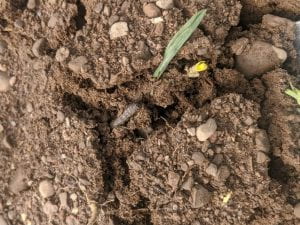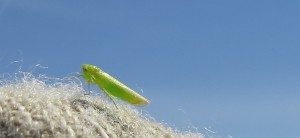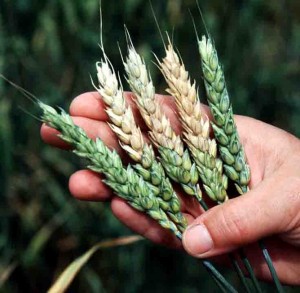Contents
View from the Field
Black Cutworm ALERT: TIME TO CHECK FIELDS!
There have been fields over threshold for black cutworm in corn. Therefore, GET OUT AND SCOUT! Check out the black cutworm degree-day model below and see what stage of larvae development is occurring in your part of the state. For more information, view the following video:
NYS IPM Black Cutworm Short Video
Black Cutworm
Potato Leafhopper on the Rise!
Potato leafhopper was found only last week in NYS. Certified Crop Advisors are reporting the populations are increasing quickly with all the heat! Time to start checking your alfalfa! For more information, view the following video:
IPM for Potato Leafhopper on Alfalfa
Cereal Leaf Beetle
There are increases in cereal leaf beetle larvae in small grains this last week. There have been a few reports of larvae over threshold. The levels range from low to high. If you have a field with cereal leaf beetle we would like to sample the larvae for a biocontrol project. Please email me at klw24@cornell.edu
For more information on small grains, insect pests view the following video:
IPM for Insect Pests of Small Grains
Alfalfa Weevil
There are reports of alfalfa weevil being over threshold across NY. In some cases, they have been very high populations. Please note that they will be pupating very soon and will not be a problem the rest of the summer. See the table below on degree-day development of the larvae.
Fusarium Head Blight Update- June 5
Dr. Gary Bergstrom-Extension Plant Pathologist-Professor
Winter wheat in New York began flowering this week and much acreage was sprayed with Caramba, Prosaro, or Miravis Ace. There is an application window of approximately 7 days from the beginning of flowering in which reasonable FHB and DON suppression can be expected from these fungicides. The risk of FHB infection in winter wheat has increased in some areas of New York over the last few days. Check the Fusarium Risk Assessment Tool (www.wheatscab.psu.edu) and your local weather forecast frequently as your winter wheat crop approaches flowering.
Black Cutworm Degree-Days by Location of Intense Catches
6/7/2021
True Armyworm Degree-Days by Location of Intense Catches
6/7/2021
Black Cutworm Moth Catches in New York
Maps will be updated as more data is entered.
True Armyworm Moth Catches in New York
Maps will be updated as more data is entered.
Degree Day Models for Alfalfa Weevil -6/7/2021
Clipboard Checklist
Keith Waldron, NYS IPM
General
*Walk fields to check tile flow, check and clear drainage outlets. Look for line breaks
*Note and record location of wet areas on field maps or aerial photo for future tiling considerations and crop decisions, check for areas of soil erosion
*Pre-plant weed evaluation, timing cultivation and/or pre-plant weed management
*Watch for early season weeds: winter annuals, chickweed, henbit, field penny cress, shepherd’s purse, giant and common ragweed, purple deadnettle, lambsquarters, redroot pigweed, velvet leaf, Pennsylvania smartweed, common sunflower, quackgrass, foxtail
Alfalfa:
*Evaluate established legume stands for winter damage (thinning stand, frost heave, Brown root rot), determine average alfalfa stand count adjust crop plans if necessary
*Monitor for alfalfa weevil, crown or foliar diseases
*Monitor new seedings for Pythium blight and Phytopthora Root Rot.
*Monitor for Alfalfa Snout Beetle (In Oswego, Jefferson, Cayuga, Wayne, Lewis, St. Lawrence, Clinton, Essex, and Franklin counties)
Small Grains:
*Monitor winter grain fields for over wintering survival (snow mold and other cold injury issues), weed issues (such, as winter annuals, corn chamomile and chickweed), growth stage, number of tillers, foliar diseases (powdery mildew, rusts)
*Check stands for soilborne virus diseases, Wheat spindle streak mosaic and Soilborne wheat mosaic, check for signs of powdery mildew or other maladies, cereal leaf beetle, weed escapes, goose damage
Corn:
*Prepare land and plant corn as conditions allow
*Pre-plant weed evaluation, timing cultivation and/or pre-plant weed management
*Emergence: assess stand, population count
Soybeans:
*Prepare land and plant soybeans as conditions allow
*Pre-plant weed evaluation, timing cultivation and/or pre-plant weed management
Pastures:
*Check and mend fences as needed.
*Check crop growth
*Monitor fields for invasive species, plants harmful to livestock
*Review/Plan rotation system
Equipment:
*Remove / clean soil and crop debris from equipment
*Arrange for custom weed control or check your own application or cultivator equipment for repairs.
*Carry appropriate / necessary NYS DEC and EPA required documents: (pesticide applicators license, pesticide labels, MSDS sheets, etc.) with application equipment
*Calibrate:
-planting equipment – maintain records on planting rate per field
-manure spreaders – maintain records on amount spread per field
-pesticide application equipment – Check nozzles, pumps, etc., recalibrate pesticide application equipment before use.
Storage:
* Check stored grain bins for temperature, moisture and signs of mold and insects. Aerate, core, transfer grain or treat as necessary
*Check forage allocation and anticipate feed program adjustments as forages from previous year are used up
*Plan where forages should be stored for optimum allocation next feeding season









